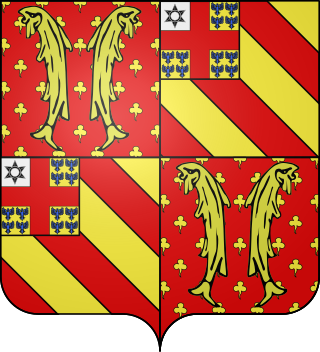Related Research Articles

René of Anjou was Duke of Anjou and Count of Provence from 1434 to 1480, who also reigned as King of Naples from 1435 to 1442. Having spent his last years in Aix-en-Provence, he is known in France as the Good King René.
Edward I, was the count of Bar from 1302 to his death. He was a minor when he succeeded his father Henry III as count, so ruled initially under the regency of his uncles, John of Puisaye, Theobald, Bishop of Liège, and Renaud, Bishop of Metz.

Theobald II was the Duke of Lorraine from 1303 until his death in 1312. He was the son and successor of Frederick III and Margaret, daughter of King Theobald I of Navarre of the Royal House of Blois.

Yolande of Aragon was Duchess of Anjou and Countess of Provence by marriage, who acted as regent of Provence during the minority of her son. Yolande played a crucial role in the struggles between France and England, influencing events such as the financing of Joan of Arc's army in 1429 that helped tip the balance in favour of the French. She was also known as Yolanda de Aragón and Violant d'Aragó. Tradition holds that she commissioned the famous Rohan Hours.

Gruffudd Fychan II was Lord of Glyndyfrdwy and Lord of Cynllaith Owain c.1330–1369. As such, he had a claim to be hereditary Prince of Powys Fadog, and was a member of the Royal House of Mathrafal. His son, Owain Glyndwr, started the Welsh Revolt and became Prince of Wales.

Yolande II or Yolande of Nevers, was ruling Countess of Nevers between 1262 and 1280.
Hugh XII de Lusignan, Hugh VII of La Marche or Hugh III of Angoulême. He was the son of Hugh XI of Lusignan and Yolande of Brittany. He succeeded his father as seigneur of Lusignan, Couhé, and Peyrat, Count of La Marche and Count of Angoulême in 1250.

Theobald II was a count of Bar. He was the son of Henry II of Bar and Philippa of Dreux. He became count of Bar when his father was killed during the Barons' Crusade in 1239, but news of Henry's death did not reach him until 1240. As Theobald was still a minor, his mother ruled as regent until 17 March 1242. Theobald's own children included his successor Henry III and the bishop Reginald of Bar.

Theobald I was Count of Bar from 1190 until his death, and a Count of Luxemburg from 1197 until his death. He was the son of Reginald II of Bar and his wife Agnès de Champagne. He became count when his brother, Henry, was killed in the siege of Acre.

Yolande of Brittany, also known as Yolande de Dreux, was the ruler of the counties of Penthièvre and Porhoet in the Duchy of Brittany. Yolande had been betrothed to King Henry III of England in 1226 at the age of seven years, but married Hugh XI of Lusignan, the half-brother of Henry III. Through Hugh, she became Countess of La Marche and of Angoulême. She was the mother of seven children. From 1250 to 1256, she acted as Regent of La Marche and Angoulême for her son, Hugh XII of Lusignan.

Guy I of Clermont-Nesle was a Marshal of France, Seigneur (Lord) of Offemont jure uxoris, and possibly of Ailly, Maulette and Breteuil. He might have been a Seigneur of Nesle also, or used the title "Sire of Nesle" due to his family. Difficulties about the seigneurie of Breteuil are present, and the status of Ailly and Maulette in relation to Breteuil.

Raoul II/III of Clermont-Nesle was Seigneur (Lord) of Nesle in Picardy (de), Viscount of Châteaudun (de), Grand Chamberlain of France and Constable of France.

Otto, Lord of Arkel was Lord of Arkel from 6 May 1360 until his death.
Not to be confounded with his uncle John II of Saarbrücken-Commercy (fr)

Simon IV, Count of Saarbrücken, Simon of Saarbrücken-Commercy. He was the Count of Saarbrücken (de) and Seigneur (lord) of Commercy (fr).

The title Count of Vaudémont was granted to Gérard 1st of Vaudémont in 1070, after he supported the succession of his brother, Theodoric II, Duke of Lorraine to the Duchy of Lorraine. Counts of Vaudémont served as vassals of the Dukes of Lorraine. After 1473 the title was held by the Duke of Lorraine and was bestowed on younger sons of the Duke. It was later restyled "Prince of Vaudémont".
Marie of Namur, also known as Marie de Namur or Maria van Dampierre. Her titles were Gräfin von Vianden, from her first marriage and Dame de Pierrepont, from her second marriage to, Theobald of Bar.
Elizabeth of Bar also known as Elisabeth (Isabel) de Bar-Pierrepont, was born c. 1345 at Hagestein, Zeeland, Netherlands. She was the youngest daughter of Theobald de Bar, Seigneur de Pierrepont and his wife Marie de Namur. When her father, Theobald, died between 2 August 1353 and 6 July 1354, and because he had no legitimate male heir, she became the heiress of Bar-Pierrepont.
Erard of Bar, was a monk by 1292 and then seigneur de Pierrepont, Meurthe-et-Moselle et d'Ancerville by 1302. Erard was one of eight sons born to Theobald II, Count of Bar and his wife, Jeanne de Toucy.